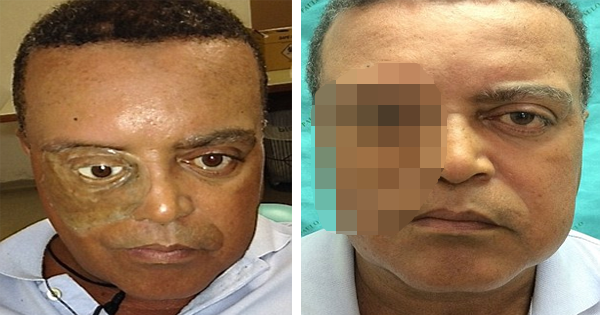Advertisement
Over eight years ago, 54-year-old Carlito Conceiçao was diagnosed with upper maxillary carcinoma, cancer of the upper palette of the mouth. The disease spread to his facial tissue and eventually ravaged much of the right side of his face.
Although Conceiçao’s doctors were able to remove the tumor and save Conceiçao’s life, they had to take out much of his face – including his right eye socket as well as part of his nose.
In 2008, when Conceiçao was deemed clear of cancer, he was fitted with a facial prosthetic, but it was uncomfortable and kept falling out. As a result, Conceiçao became depressed and retreated into the safety of his home. He was too anxious to wander out into public.
“My first prosthesis was fragile, poor quality and kept falling off because it was held on by glue. I felt totally disfigured and I looked terrible,” he recalled. “I lost all my confidence and fell into a deep depression. I couldn't work and became a recluse because people would stare and point whenever I went out. I used sunglasses to cover up the area most of the time.”
Earlier this year in February, however, Conceiçao was presented the opportunity to take part in an innovative procedure where doctors used new smart phone technology to create him a new, better-fitting prosthetic.
Dr. Rodrigo Salazar from the Paulista University (UNIP) in Sao Paulo has been spearheading this project.
He and his research team have developed an app, Autodesk 123D Catch, that turns photos into 3-D models. “The rational for using a smartphone is that all modern mobile devices have an integrated accelerometer and a gyroscope sensor,” Dr. Salazar explained, “which are automatically run by the application to guide the operator's 3D position during the photo capture sequence.”
Smart phones are also far more accessible than old prosthetic-creation technology, which cost hundreds of thousands of dollars to use.
To make Conceiçao’s prosthetic, Dr. Salazar took 15 photos of Conceiçao’s face and “mirrored the healthy side” to “digitally sculpt[] it to fit the trauma side.”
The result was then printed on a 3-D printer and fitted by a surgeon into Conceiçao’s face. The results are amazing.

Conceiçao confessed that he cried during his first fitting because it was so much better than his old prosthetic.
Doctors aren’t precisely certain how long this prosthetic will last, but they project that it will be another one to three years before Conceiçao has to get a replacement made. For now, this prosthetic means that Conceiçao will once again be confident enough to “go to the beach, take a shower, go to the gym and run without fear.”




